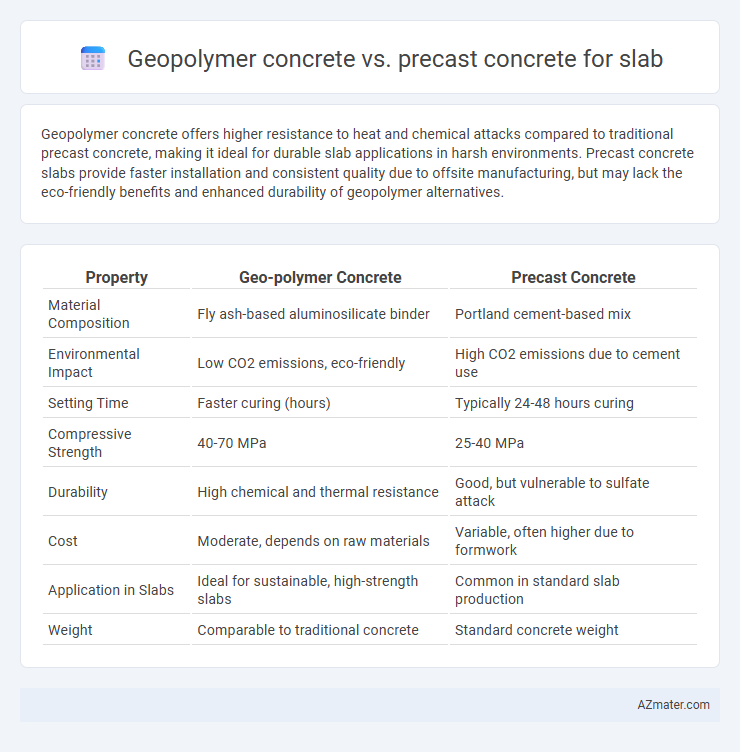Geopolymer concrete offers higher resistance to heat and chemical attacks compared to traditional precast concrete, making it ideal for durable slab applications in harsh environments. Precast concrete slabs provide faster installation and consistent quality due to offsite manufacturing, but may lack the eco-friendly benefits and enhanced durability of geopolymer alternatives.
Table of Comparison
| Property | Geo-polymer Concrete | Precast Concrete |
|---|---|---|
| Material Composition | Fly ash-based aluminosilicate binder | Portland cement-based mix |
| Environmental Impact | Low CO2 emissions, eco-friendly | High CO2 emissions due to cement use |
| Setting Time | Faster curing (hours) | Typically 24-48 hours curing |
| Compressive Strength | 40-70 MPa | 25-40 MPa |
| Durability | High chemical and thermal resistance | Good, but vulnerable to sulfate attack |
| Cost | Moderate, depends on raw materials | Variable, often higher due to formwork |
| Application in Slabs | Ideal for sustainable, high-strength slabs | Common in standard slab production |
| Weight | Comparable to traditional concrete | Standard concrete weight |
Introduction to Geo-polymer and Precast Concrete
Geo-polymer concrete is an innovative, eco-friendly building material composed of industrial by-products like fly ash or slag, activated by alkaline solutions to form a durable binder with low carbon emissions. Precast concrete involves casting concrete elements in a controlled factory environment, ensuring high quality and consistent strength before transporting them to construction sites for rapid assembly. Both materials offer distinct advantages for slab construction, with geo-polymer concrete emphasizing sustainability and precast concrete focusing on speed and uniformity.
Key Differences Between Geo-polymer and Precast Concrete
Geo-polymer concrete is a sustainable alternative utilizing industrial by-products like fly ash or slag activated by alkaline solutions, offering enhanced chemical resistance and lower carbon emissions compared to traditional concrete. Precast concrete slabs are manufactured in controlled factory settings, ensuring consistent quality, rapid installation, and reduced onsite labor costs, but typically rely on Portland cement with higher environmental impact. Key differences include Geo-polymer concrete's eco-friendly composition and durability against acids, while precast concrete emphasizes precision, uniformity, and time efficiency in construction.
Material Composition and Environmental Impact
Geopolymer concrete for slabs is composed primarily of industrial by-products such as fly ash or slag activated by alkaline solutions, reducing reliance on traditional Portland cement. In contrast, precast concrete slabs typically utilize conventional Portland cement mixed with aggregates, water, and admixtures, resulting in higher carbon dioxide emissions during cement production. The use of geopolymer concrete significantly lowers the environmental impact by minimizing greenhouse gas emissions and promoting the recycling of industrial waste materials compared to precast concrete slabs.
Strength and Durability Comparison
Geopolymer concrete offers superior resistance to chemical attack and high temperatures due to its inorganic polymer binder, enhancing long-term durability compared to traditional precast concrete slabs made from Portland cement. The compressive strength of geopolymer concrete can exceed 70 MPa, surpassing typical precast concrete strengths, which generally range between 30 to 50 MPa. Enhanced durability characteristics such as reduced permeability and improved resistance to sulfate and chloride ingress make geopolymer concrete slabs ideal for harsh environments where durability is critical.
Installation and Construction Methods
Geo-polymer concrete slabs offer a rapid installation process due to their lower curing time compared to traditional cement-based precast concrete, enabling faster project turnaround. The construction method for geo-polymer concrete involves mixing fly ash or slag with alkaline activators, which demands precise chemical handling but results in high early strength and durability. Precast concrete slabs, manufactured off-site and transported for assembly, require crane lifting and joint sealing during installation, making the process dependent on logistics and site accessibility.
Cost Analysis for Slab Applications
Geopolymer concrete for slab applications typically offers cost advantages due to lower raw material prices, especially when utilizing industrial by-products like fly ash, reducing cement consumption and associated carbon emissions. Precast concrete slabs involve higher initial manufacturing and transportation costs but benefit from faster on-site installation and quality control, potentially lowering overall project timelines. Lifecycle cost analysis often favors geopolymer concrete for sustainability and durability, while precast concrete excels in standardized, high-volume production scenarios.
Thermal and Chemical Resistance
Geopolymer concrete exhibits superior thermal resistance compared to traditional precast concrete, maintaining structural integrity at temperatures exceeding 1000degC due to its aluminosilicate binder. Its chemical resistance is enhanced by a low calcium content, rendering it highly durable against acidic and sulfate-rich environments where precast concrete may deteriorate over time. These properties make geopolymer concrete an optimal choice for slabs in high-temperature and chemically aggressive applications.
Sustainability and Recycling Potential
Geo-polymer concrete offers superior sustainability compared to precast concrete slabs due to its use of industrial by-products like fly ash and slag, significantly reducing carbon emissions during production. It demonstrates enhanced recycling potential by allowing easier reuse of hardened materials and reducing reliance on virgin aggregates. Unlike traditional precast concrete, geo-polymer variants contribute to lower environmental impact throughout their lifecycle, making them a greener choice for slab construction.
Case Studies: Real-world Slab Projects
Case studies reveal geopolymer concrete slabs exhibit superior durability and sustainability compared to traditional precast concrete slabs, with projects in Australia and India demonstrating reduced carbon emissions by up to 70%. Geopolymer concrete slabs showcase enhanced resistance to chemical attacks and thermal stability, making them ideal for industrial and marine environments, as evidenced by infrastructure applications in Singapore and the UAE. Precast concrete slabs remain widely used due to faster installation and uniform quality, supported by large-scale developments in the US and Europe, though lifecycle analyses favor geopolymer solutions for long-term environmental benefits.
Conclusion: Choosing the Right Concrete for Slabs
Geo-polymer concrete offers enhanced durability, reduced carbon footprint, and superior chemical resistance, making it an eco-friendly choice for slabs in aggressive environments. Precast concrete provides high-quality control, faster installation times, and consistent structural performance, ideal for projects prioritizing speed and uniformity. Selecting between geo-polymer and precast concrete for slabs depends on environmental conditions, project timelines, and sustainability goals.

Infographic: Geo-polymer concrete vs Precast concrete for Slab
 azmater.com
azmater.com